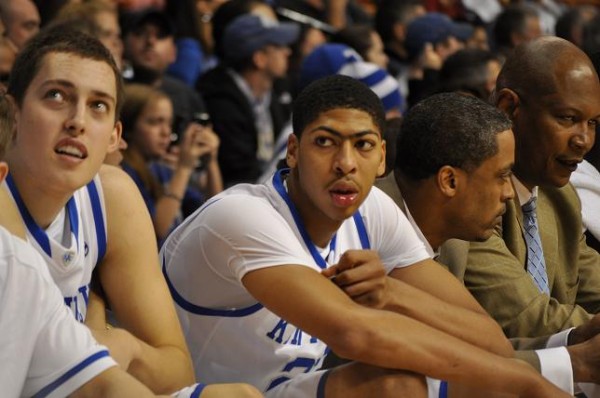An Analysis of Anthony Davis’ Involvement in Kentucky’s Offense
Posted by Brian Joyce on December 22nd, 2011In his brief college career, Anthony Davis is better known for his defensive presence as he is still developing his offensive skills. In his power rankings earlier this month, Luke Winn charted Davis’ possessions playing in John Calipari’s offensive sets in the game against North Carolina. A concerning trend emerged that Davis received the ball in the post on just 5.7% of his touches. Winn stated that “one gets the sense that the Wildcats are still figuring out how best to use him on offense, even though he’s shooting 70.9 percent on his two-point attempts.” You may remember we analyzed Kentucky’s use of the post game in a piece just a few days earlier. I believe that Calipari’s use of Davis on the perimeter is done purposely with the intent of opening him up for a cut into the lane to set up the lob pass as you can see in both play #1 and #2 of that post. Davis is not going to overpower opposing big men. His strengths are his quickness and athleticism for a 6’11” center, and it seems like Calipari is setting Davis up to take advantage of slower fives.
With Terrence Jones out with a dislocated finger, Kentucky’s biggest (and only) post threat was on the sidelines for Tuesday’s warm-up game with Samford. Davis has not been utilized as a post-up player this season, likely because he weighs all of 220 pounds. However, Samford’s center Drew Windler is 6’9″ and 195 pounds. If ever there was a time to post Davis up, Tuesday night would have been the night. It seemed like now would be a good time to do a follow up on Winn’s original work, so I decided to chart each of Anthony Davis’ touches on offense.
This is a play by play of each possession in which Davis touched the ball within the Kentucky offense against Samford:
1st Half –
- 18:58: Lay-up in transition (two points)
- 17:01: Received the ball at the top of the key, passed out
- 15:03: Top of the key, passed down in the post to Michael Kidd-Gilchrist and cut through the lane
- 14:25: On the wing, took a three point shot (missed)
- 10:01: On the wing, hand-off to Doron Lamb
- 9:00: Top of key, passed back to Marquis Teague
- 7:27: Offensive rebound about fifteen feet out, passed out
- 6:37: Top of key, passed to Lamb
- 5:54: Top of key, hand-off to Kidd-Gilchrist
- 4:53: Dunked an offensive rebound on a Kyle Wiltjer miss (two points)
1st Half Summary:
10 possessions
- 7/10: Received the ball beyond the three-point line – 70% of possessions
- 1/10: Transition – 10%
- 2/10: Offensive rebounds – 20%
2nd Half:
- 19:39: Top of key, hand-off to Teague
- 18:45: Steal and drive length of the court (missed lay-up)
- 18:22: Top of key, drive and miss
- 18:20: Grabbed his own offensive rebound and passed out
- 18:10: Top of key, hand-off to Lamb
- 17:03: Top of key, hand-off to Teague
- 12:18: Received lob pass for a dunk (two points)
- 11:15: Wing, passed in to Eloy Vargas posting up and cut through lane
- 9:18: Top of key, hand-off to Teague
- 5:46: Post up catch and hook, fouled (2-2 FT)
- 3:41: Post up catch,pass back out
2nd Half Summary:
12 possessions
- 6/12: Received the ball beyond the three-point line – 50%
- 1/12: Transition – 8%
- 1/12: Lob pass – 8%
- 2/12: Post up – 16%
- 2/12: Offensive rebound – 16%
Game Summary:
22 possessions
- 13/22: Received the ball beyond the three-point line – 59%
- 2/22: Transition – 9%
- 1/22: Lob pass – 4%
- 2/22: Post up – 9%
- 4/22: Offensive rebounds – 18%
- 8 points, 9 rebounds (3-7 FG shooting)
This is obviously a small sample size, but there are some trends that continue to emerge. Calipari is simply not utilizing Davis in the low post. Calipari has him receiving the ball beyond the three-point line, and only then looking to hand the ball off to a guard or feed the ball into the post. Immediately after the pass in either situation, Davis cuts to the basket looking to receive the ball for a lob or an easy dunk in transition. Davis is also being utilized in the pick-and-roll, where he attempts to use his quickness to beat the defender to the basket. Offensive rebounds are a big source of Davis’ offensive involvement. Two of his eight points and 18% of his touches were as the result of an offensive rebound, so when he wants the ball he often has to go get it himself.
While the focus on Davis is typically on his defensive prowess, his importance in Kentucky’s offense should not be minimized. He is averaging 11.5 points per game on 70% shooting from two-point field goal range (67.1% eFG, according to kenpom.com – subscription required). Calipari utilizes Davis in a way that capitalizes on his length, but minimizes his weaknesses so that his lack of physical strength is not exposed. Davis needs to continue to work on his offensive skills, as he is a game changer if he can develop a few post moves and a solid mid-range game similar to what John Henson does for North Carolina. And if Davis can improve his limitations within half-court sets, not only should his role in the offense increase, but Calipari might just get him the ball a little closer to the basket.













































